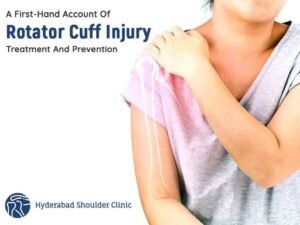Shoulder pain is one of the most common reasons to seek shoulder pain specialists such as orthopaedic surgeons, sports doctors, physical therapists, or chiropractors.
Most people don’t know how often they use their shoulders in many activities. Whether you’re combing your hair, wearing a shirt, throwing a ball, or even writing a letter, your shoulders play a very important role. It can be very debilitating if a person has shoulder pain from tendonitis or a rotating cuff injury.
It may take some time for the shoulder tendonitis to heal. In this article provided by Dr Chandra Shekar B are shoulder exercises to avoid that can further pinch your shoulders.
What is shoulder tendonitis?

Shoulder tendonitis occurs when the rotator cuff muscles become inflamed. Shoulder tendinitis can also develop if the bicep tendon connected to the rotator cuff becomes inflamed. As with other shoulder injuries, shoulder tendonitis’s severity can vary from relatively mild to very severe. Some of the symptoms that people may notice that indicate they have tendonitis are:
- Swelling or redness of the shoulder
- Shoulder pain that gets worse when the shoulder is moved
- Shoulder pain that gets worse when you are lifting weights
If a person has shoulder pain, they can try various treatment options to relieve the discomfort. This can be a painless medication, a heating pad, or an ice pack. Also, there are several exercises you should avoid if you are diagnosed with shoulder tendonitis.
5 Exercises To Avoid with Shoulder Tendonitis and Rotator Cuff tear
- Throwing balls over your head, especially heavy ones.
- Avoid swimming, especially kicks.
- Lifting weights that put pressure on the shoulder and rotator cuff
Over time, the inflammation in the shoulder gradually reduces, and people make a full recovery.
Lifting the weights above your head
People with shoulder injuries should initially refrain from exercises that encourage any movement or movement overhead. Forget about activities like throwing a ball or specific weight training at the gym like overhead presses and pull-ups. These movements can cause more stress and even additional injury and pain in the injured area.
Pulldown Behind the neck

Whether it’s a dumbbell or a dumbbell attached to a cable, pulling the neck’s back is an exercise to avoid. Why? This movement puts unnecessary pressure on the rotator cuff and carries the risk of additional shoulder problems and chronic pain.
The problem with pulling behind the neck is “external rotation”. As you pull down yourself behind your neck, you need to rotate your shoulders as much as possible. This is a very difficult position for your shoulders. This movement can cause unstable joints and stretch the tissue, which can lead to injury.
Upright Row:
Even though the upright row is one of the most common exercises you’ll see in the gym, take a quick look at the mechanics of this exercise, and you’ll understand why it’s a poor exercise for rotational handcuffs and other injured wounds.
The problem with the exercise lies in the position of your hands. This position is called “internal rotation”. When you raise your arm, the small tendons in your shoulder become trapped by the bones in your shoulder. This can cause excessive wear over time.
You may not feel it right away, but the tendons will gradually wear out and break down. The risk is not worth the reward. Here’s what you can do in Muscle & Fitness magazine, or try a modified vertical row.
Pushing back the neck
Exercises for the press on the back of your neck, like the military press, can be a quick ticket to injury.
To perform a pressing movement behind the neck, you need to rotate the shoulders as much as possible. This places your shoulders in a vulnerable position against your shoulder girdle (the bone that connects the frame to your arms) and can put serious pressure on your rotator cuff. Research also shows that most men don’t have the mobility necessary to get the press behind the head’s shoulders properly. Another reason this is an exercise for shoulder tendonitis should be avoided.
Bench Dips or triceps dips

The main muscle that targets contraction is the triceps muscle. Unfortunately, this move is on the “no” list because the drip requires too much internal rotation of the shoulder and can put pressure on the rotator cuff.
To perform a dip, the shoulders must approach the final extension area, causing the humeral head to move forward.
Conclusion:
Shoulder tendonitis can be a painful injury that makes it difficult for people to use their arms. If someone needs medical intervention because of a shoulder injury, they should trust the doctor at Hyderabad Shoulder Clinic. Our team of licensed and experienced therapists can help you return to a healthy and active lifestyle while providing long-term assistance and reduced risk of injury.
Our Dr Chandra Shekar B can provide Rotator cuff injury care and care for shoulder tendonitis. Dr Chandra Shekar B can perform surgical procedures if needed. If you experience shoulder pain, call our team at 9959588389 today to make an appointment. We are happy to help you and your family with all your medical needs.





